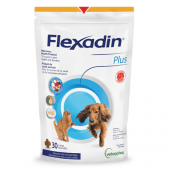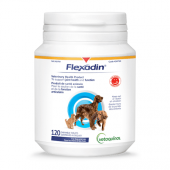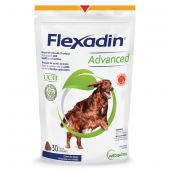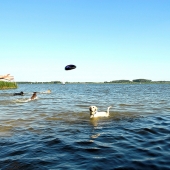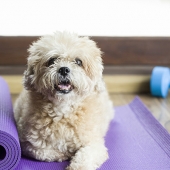Approximately 35% of dogs (over the age of 4) and 20% of cats (over the age of 2) live with osteoarthritis, a degenerative disease that causes joint swelling and pain and hinders mobility. Early symptoms may be mistakenly attributed to aging, or your pet may naturally hide their pain. While this condition remains incurable, there are many things you can do to help your furry friend enjoy a pleasant and fulfilling life.
1.Help your pet achieve (and maintain) a healthy weight.
In North America, up to 45% of dogs and 50% of cats (aged 5–11 years old for both) are overweight[1],2. Shedding a few pounds helps relieve stress on weight-bearing joints such as knees, hips and elbows. Ask your veterinary clinic for recommendations on weight-control strategies, which may include specially formulated food so your pet won’t feel hungry despite consuming fewer calories.
2.Make sure your pet gets daily exercise.
Keeping your cat or dog physically active helps them achieve the weight management goals set by your veterinarian and improve their overall fitness. Daily exercises such as walking, playing fetch, or various indoor and backyard games help the muscles surrounding the joints grow stronger to better support your pet’s weight and relieve joint pain. Ask your veterinarian for advice—depending on your pet’s condition, they may recommend avoiding high-impact activities like running or jumping, or suggest walking on softer surfaces such as grass rather than pavement.
3.Add rugs over slippery indoor surfaces.
Hardwood, vinyl, tile and laminate floors can be slippery for your four-legged friend and be more challenging to walk on. Consider adding area rugs with non-slip backings and anti-slip stair treads to help your pet move around the house safely and comfortably. Finally, keep your pet’s nails neatly trimmed to help their mobility.
4.Use raised food and water bowls.
Elevated feeders allow your pet to drink or eat without bending, reducing the strain on their neck, hips, shoulders and joints. Some models also help keep the feeding area tidy and clean since you can either wipe the floor or the elevated surface without moving the bowls.
5.Make your pet’s favourite spots more accessible.
Stiff or painful joints may make it more difficult for your pet to climb or jump onto their favourite resting spots. Use ramps, steps or low furniture to provide them with a safe and more accessible path to their destination.
6.Offer your pet a massage.
Many veterinarians agree that, with proper guidance, giving your pet regular massages can help relieve joint pain.
7.Consider natural supplements.
Ask your veterinarian if joint supplements designed for pets could help slow down osteoarthritis progression and relieve joint pain. For example, Flexadin Advanced chews contain undenatured type II collagen, a unique ingredient that has been found to reduce joint discomfort and lameness, and Boswellia serrata, a plant native to India with anti-inflammatory properties. Flexadin Plus is suitable for cats and dogs and combines glucosamine and chondroitin (both natural cartilage compounds) with devil’s claw, a medicinal plant traditionally used to relieve joint pain.

